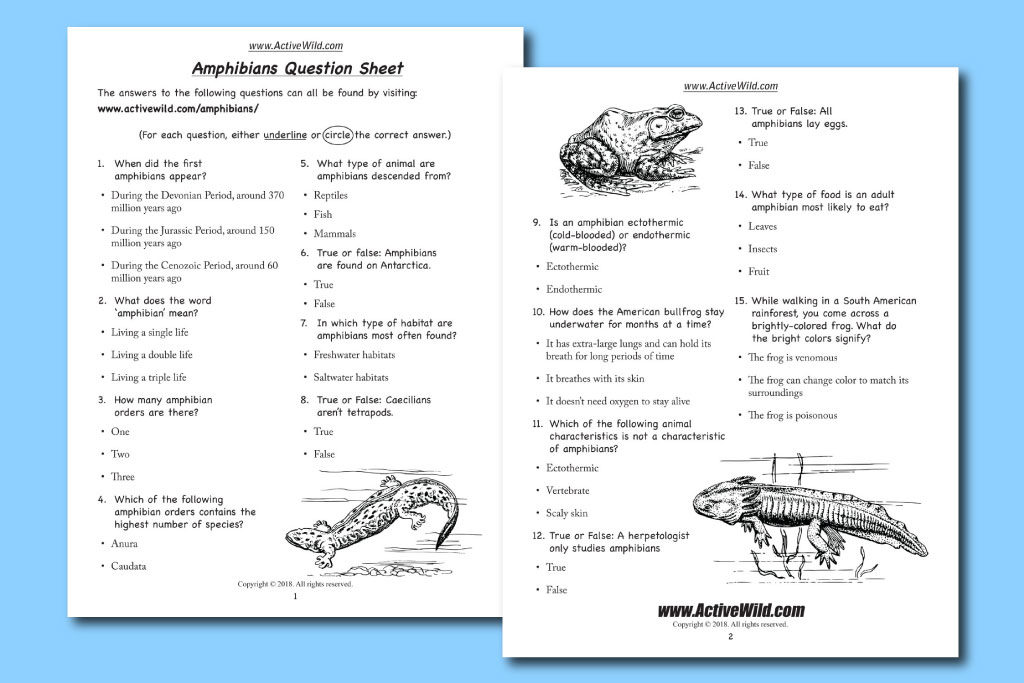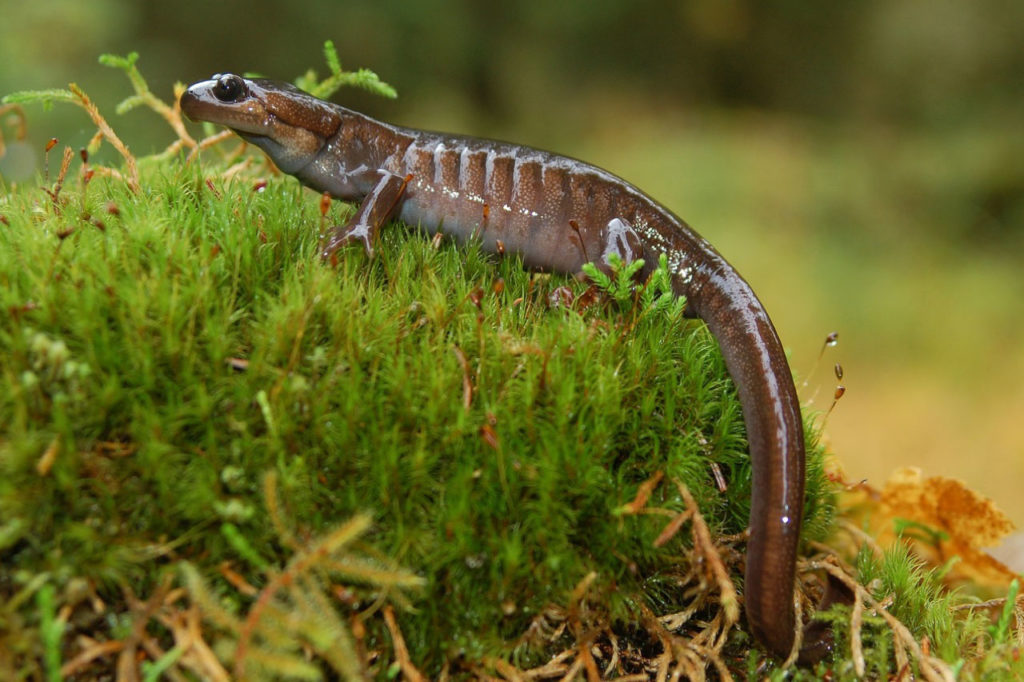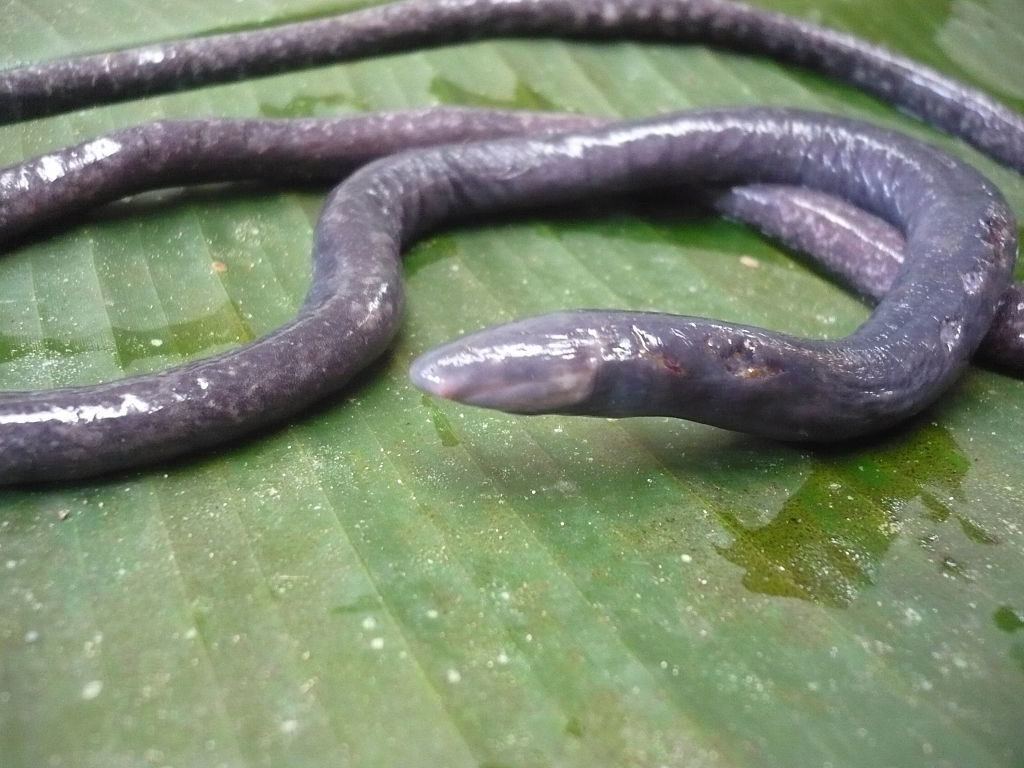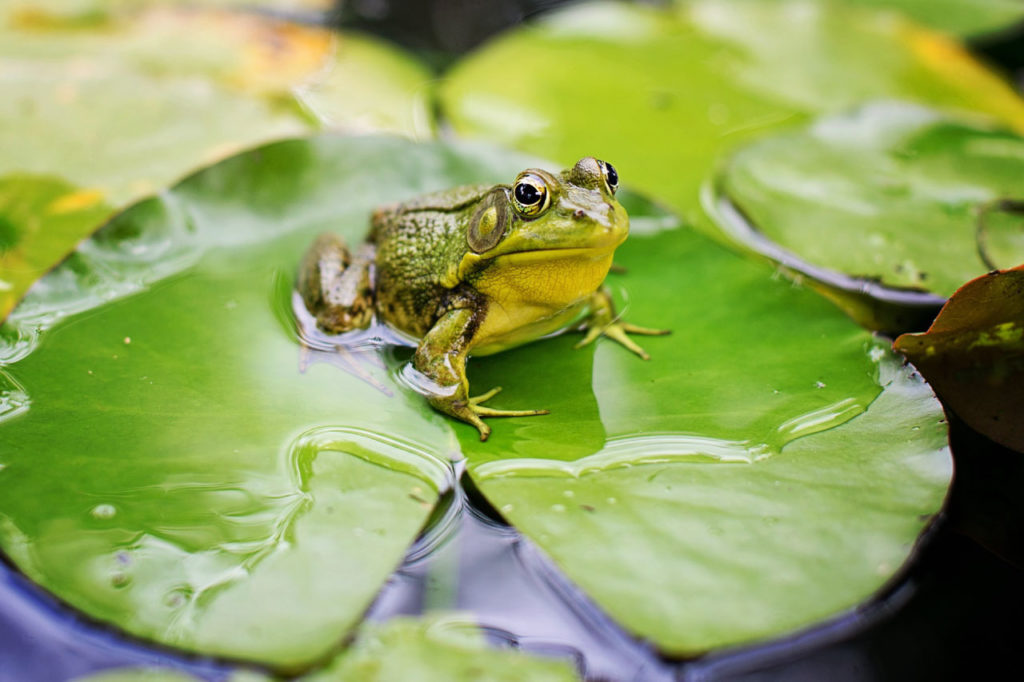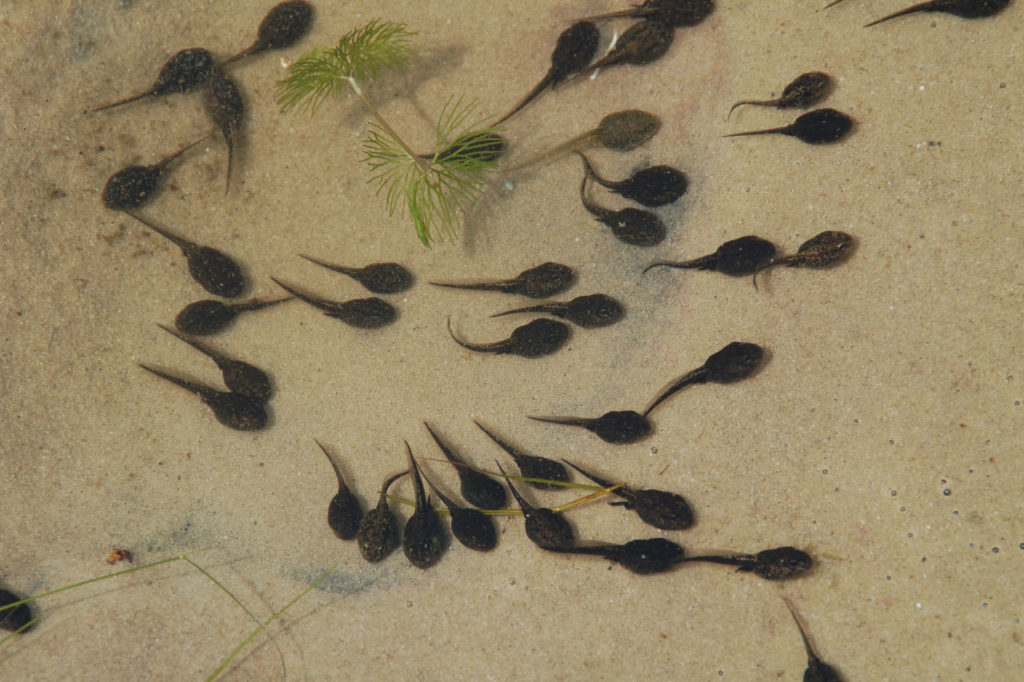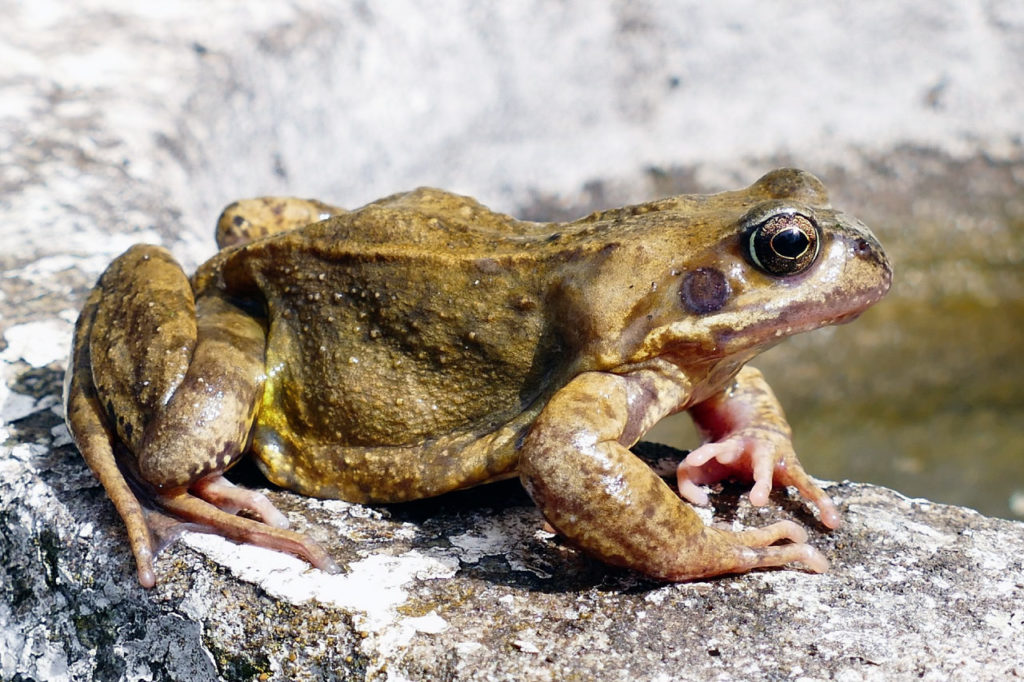Amphibians: The Ultimate Guide. On this page you’ll find out what an amphibian is, how amphibians evolved, and the different types of amphibian alive today. On the way you’ll meet some amazing amphibians, both extinct and living.
Amphibians: The Ultimate Guide
Page Index
- Introduction
- What Does ‘Amphibian’ Mean?
- How Many Species Of Amphibian Are There?
- What Is An Amphibian?
- Breathing With The Skin
- Amphibian Characteristics
- People Who Study Amphibians
- Amphibian Life Cycle
- Amphibian Reproduction & Parental Care
- Types Of Amphibian
- Amphibian Evolution
- What Do Amphibians Eat?
- Amphibian Defensive Strategies
Other Amphibian Pages On Active Wild
- You can see examples of different amphibians on this page: List Of Amphibians With Pictures & Facts
- You'll find awesome amphibian books in our Natural History Bookstore
Discover amphibians from all around the world...
- African Amphibians
- Asian Amphibians
- Australian Amphibians
- British Amphibians
- European Amphibians
- North American Amphibians
- South American Amphibians
Free Printable Amphibians Question Sheet
Are you an amphibian expert? Download your FREE printable question sheet to find out! (All of the answers can be found on this page.) An answer sheet can be found here.
Amphibians: Introduction
Amphibians are animals that have adapted to living both in the water and on land. They appeared around 370 million years ago, during the Devonian Period.
Amphibians were the first vertebrates (animals with backbones) to be able to live out of water.
Amphibians lead amazing ‘double lives’. A typical amphibian begins life as an aquatic animal (i.e. it lives in water). Its body is equipped with gills (organs that allow it to 'breathe' underwater) and a finned tail for moving through the water.
The amphibian then undergoes a change called metamorphosis. During metamorphosis an amphibian's body changes from its larval form into its adult form. Its gills are absorbed back into its body and the amphibian develops lungs, which allow it to breathe air.
In its adult form, the amphibian is able to leave the water and live on land. It then returns to the water to breed.
The above describes a ‘typical’ amphibian. Some amphibians never leave the water, some retain their gills in adulthood, and others never grow lungs and instead ‘breathe’ through their skin!
What Does ‘Amphibian’ Mean?
The word ‘amphibian’ refers to the animals’ amazing double lives. It means ‘two lives’, or ‘both kinds of life’. The word is derived from the Greek words: amphi and bios, which mean ‘of both kinds’ and ‘life’ respectively.
The 3 Types Of Living Amphibian
- An 'order' is a group of related animals. You can find out more about orders here: Animal Classification
- You can find out more about the different types of amphibian further down the page.
All amphibians alive today are members of the subclass Lissamphibia.
How Many Species Of Amphibian Are There?
There are around 6,771 species of amphibian.
There are around 5,966 species in Anura (frogs and toads), 619 species in Caudata (salamanders), and 186 species in Gymnophiona (caecilians).
What Is An Amphibian?
An amphibian is a member of the animal class Amphibia. It is a vertebrate, which means that it has a backbone. Like all vertebrates, amphibians evolved from fish many millions of years ago.
Today, amphibians are found on every continent except Antarctica. They are freshwater animals, and very rarely found in saltwater habitats.
The crab-eating frog (Fejervarya cancrivora) of Southeast Asia is the only known amphibian able to tolerate seawater (and then only for short periods).
Four-Legged Ancestors
An amphibian is a tetrapod. As fish began to evolve into amphibians, a completely new type of animal body structure appeared. This new type of body had four limbs, and feet equipped with digits (toes / fingers).
Animals with this type of body (and animals whose ancestors had this style of body) are known as tetrapods. All amphibians, reptiles, birds and mammals (including humans) are tetrapods.
You’re a tetrapod, and in the distant past your ancestors were fish. Sorry to break it to you like this!
Although they lack limbs, caecilians are tetrapods because they evolved from the same four-limbed animals as other amphibians.
Cold-Blooded Animals
Amphibians, like reptiles, are ‘ectothermic’, or ‘cold-blooded’. This means that – unlike endothermic, or warm-blooded, animals such as mammals – amphibians do not generate their own body heat.
An amphibian is unable to adjust its own body temperature, and is reliant on its environment to attain the correct body temperature.
Being ectothermic can be restricting, but it does have its advantages. Generating body heat requires a large amount of energy. Warm-blooded animals are therefore required to eat large amounts of food, and spend much of their lives foraging.
Without continuously having to look for food, ectotherms such as amphibians can spend more of their time just ‘chilling out’ (or, more precisely, warming up).
Living A ‘Double Life’ In Water & On Land
The lives of (most) amphibians are split into two separate stages: an aquatic larval stage, and a land-based adult stage.
In the aquatic stage of a typical amphibian’s life, it has gills and lives in water.
It will then go through a process called ‘metamorphosis’. During metamorphosis an amphibian’s body undergoes the changes that allow it to live on land.
The bodies of many adult amphibians look entirely different to their infant forms. Just think how different a tadpole is to an adult frog – it’s as if they’re two different animals rather than the same individual in different stages of its life!
Although most adult amphibians are able to live on land, they still require freshwater to reproduce. However, there are exceptions: some tropical frogs are able to reproduce without a source of water. Their young go through the tadpole stage of their development while still in the egg, and hatch in their adult form.
Several species of narrow-mouthed frog that inhabit Australia and New Guinea are examples of amphibians that hatch in their mature form.
Breathing Through The Skin
Amphibians are able to ‘breathe’ through their skin. Breathing through the skin is known as ‘cutaneous respiration’. Amphibian cutaneous respiration can take place both on the land and in the water. Some frogs – such as the American bullfrog – can spend the entire winter hibernating in the mud at the bottom of a pond.
Some amphibians are more reliant on cutaneous respiration than others. For example, many adult salamanders lack lungs entirely. In these species, gas exchange takes place through the skin and via tissue in the mouth and pharynx (the area behind the mouth).
A network of capillaries (very thin blood vessels) lies close to the surface of an amphibian’s skin. This allows gas to be exchanged between the amphibian’s blood and the air or water in which it lives. In order for this gas transfer to take place, an amphibian’s skin is damp and often slimy.
Although cutaneous respiration requires less energy than breathing via lungs or gills, it can only take place at a constant rate. Most amphibians have lungs to handle respiration at a greater rate when required.
Moist Skin
An amphibian’s skin lacks scales, feathers or hair. It is thin and permeable to water.
Because an amphibian lacks the impermeable skin of an animal such as a reptile or a mammal, it is in constant danger of dehydration (drying out). Secretions from mucous glands in an amphibian’s skin help to keep it moist. An amphibian can also absorb water via its skin.
Because they have to stay moist, most amphibians are restricted to damp environments and are unable to survive in dry habitats.
Characteristics Of Amphibians
- Vertebrate (amphibians have backbones)
- Tetrapod (all amphibians – even those without legs – are descended from animals that had four legs)
- Ectothermic (amphibians do not generate their own body heat)
- Two Distinct Life Stages (the lives of most (but not all) amphibians are split into an aquatic larval stage and an air-breathing adult stage.)
- Lay Eggs in Fresh Water (most – but not all – amphibians need fresh water in which to lay their eggs.)
- Skin Breathing (an amphibian’s skin is rich with capillaries – thin blood vessels that allow gas exchange between the animal’s blood and the surrounding air or water.)
- Skin Without Scales, Feathers or Hair
- Digits Without Claws
- Usually Found In Damp Environments (amphibians can lose water through their thin, water permeable skin. To prevent drying out, they need to remain in damp environments.)
Other characteristics that separate amphibians from their fish ancestors include: a tongue, which allows food to be manipulated in the mouth; eyelids and tear ducts to protect and moisten the eyes; ears; a sound-producing organ called the larynx; and the Jacobson’s organ, which is situated in the nasal cavity and provides the senses of smell and taste.
People Who Study Amphibians
Batrachology is the branch of zoology concerned with the study of amphibians.
Many people who study amphibians are also interested in reptiles. Herpetology is the branch of zoology concerned with the study of both amphibians and reptiles.
Typical Amphibian Life Cycle
Egg
Most amphibian eggs are surrounded by a clear jelly-like substance. They are laid either singly or in strands or clusters.
Most amphibians lay their eggs in body of fresh water. This can be a lake, a river or stream, a marshy area, a puddle, or even a pool of water formed inside the leaves of a plant that itself is growing in a tree.
As usual, there are exceptions. Some amphibians don't need a body of water in order to breed, instead laying their eggs underground on land. Not all amphibians lay eggs; around three-quarters of caecilians give birth to live young, as do some frogs and salamanders.
Larva
Most amphibians go through an aquatic larval stage during which they live in water.
The larvae of salamanders resemble adults, but are smaller in size and have external gills.
Frog larvae are known as tadpoles. They are completely different in appearance to adult frogs, having tails and lacking limbs.
Adult
Although in their adult form most amphibians are able to survive away from water, they still need to remain in a damp environment in order to prevent drying out.
Several salamander species reach adulthood without going through metamorphosis. They retain their gills and are aquatic throughout their lives.
- Examples of amphibians that don’t metamorphose include the axolotl and the common mudpuppy.
Amphibian Reproduction & Parental Care
Amphibians reproduce in a number of ways. Caecilians employ internal fertilization, with the male inserting a special organ into the female.
Salamanders also use internal fertilization, but in their case the male deposits sperm on the river / lake bed, which the female then takes inside of her.
Frogs employ external fertilization. This often involves the male holding onto the back of the female, and fertilizing the eggs as they are being laid.
Amphibian Parental Care
(Some) amphibians are surprisingly good parents! After laying their eggs, they will often stick around to guard their egg clutches from predators. Amphibians will also look after the eggs by keeping them aerated by fanning water over them, and removing any dead or infected eggs.
Amphibian parental care doesn’t stop once the eggs have hatched: some species of poison dart frog transport the newly hatched tadpoles to a suitable source of water by carrying them on their backs.
Types of Amphibian
As we’ve found, living amphibians can be split into three groups, or orders:
- Anura (Frogs & Toads)
- Caudata (Salamanders & Newts)
- Gymnophiona (Caecilians)
Anura (Frogs & Toads)
Anura – the amphibian order that includes all frogs and toads – is by far the biggest amphibian group. It contains around 6,000 species.
There is no real scientific definition between a frog and a toad; members of Anura that have drier, warty skin tend to be known as toads.
Adult frogs lack tails – in fact, the name ‘Anura’ comes from the Greek for ‘without tail’. Their well-developed hind legs and webbed hind feet assist in jumping and swimming. Many frogs live in trees, and some species lay their eggs in pools formed by the leaves of plants that themselves grow in the treetops.
Frog larvae are known as tadpoles. Newly-hatched tadpoles lack limbs and have tails. They breathe with internal gills.
As they develop, the tadpoles grow limbs and lose their tails, finally changing into miniature frogs that are able to leave the water. Whereas tadpoles are herbivorous, most adult frogs are carnivorous.
Caudata (Salamanders & Newts)
Most salamanders have long, lizard-like bodies, with two pairs of short legs.
Sirens and amphiumas are types of salamander that have lost their hind limbs and whose front legs are very small, giving them an eel-like appearance.
A salamander has a tail in both its larval and adult forms (unlike a frog). Salamander larvae usually have external gills which extend from either side of the back of the head and have a feathery appearance.
Salamanders are able to regenerate (grow back) lost limbs and other body parts!
The world’s two largest amphibians are both salamanders. They are the Chinese giant salamander and the closely-related Japanese giant salamander.
Newts are salamanders in the subfamily Pleurodelinae. Even as adults newts tend to be semi-aquatic, spending most of their lives in the water.
Gymnophiona (Caecilians)
There are around 200 caecilian species. Most live underground, but some are aquatic. The eyes of caecilians are covered with skin, but are probably capable of discerning between lightness and darkness.
Most caecilians give birth to live young, but some species lay eggs. Caecilians are present in tropical regions in Asia, Africa and the Americas.
- You can find out more about caecilians here: Caecilian Facts
Amphibian Evolution
Amphibians are the earliest terrestrial (land-based) vertebrates. They appeared around 370 million years ago, during the Devonian Period.
Amphibians evolved from a group of fish called Sarcopterygii, or ‘lobe-finned fish’. The fins of these fish gradually evolved into limbs. The fish also evolved lungs, possibly as an adaptation for coping with dry periods.
The Sarcopterygii are the ancestors of the tetrapods – a group of four-legged animals that includes not just the amphibians, but also all reptiles, birds, and mammals (including humans).
Although most lobe-finned fish are now extinct, some, including the two marine coelacanths and the six freshwater lungfish species, survive to this day.
(As the descendants of the same species that gave rise to the tetrapods, the remaining lobe-finned fish are more closely-related to reptiles and mammals than they are to 99% of other fish.)
As the first vertebrates to adapt to life out of the water, the amphibians had a huge advantage over their water-based ancestors. With a whole new environment to expand into, and a wide range of early invertebrate prey, the early amphibians thrived.
What Do Amphibians Eat?
Nearly all adult amphibians are carnivores. Most prey mainly on invertebrates, but some will also take small vertebrates such as other amphibians, fish, reptiles, and even mammals. Amphibians generally aren’t too fussy about what they eat, and will take any prey that is available and will fit in their mouths!
The larvae of most amphibians are herbivorous. However, plant matter forms a major part of the diet of only a very few adult amphibians.
Most amphibians hunt by sight, and often respond to the movement of their prey. Salamanders usually catch their prey using just their mouths, although some species also use their tongues. Most frogs capture their prey with their tongues, which can be extended and retrieved extremely quickly.
Amphibians usually swallow their prey whole.
Amphibian Defensive Strategies
Amphibians are important sources of food for many other animals. In order to avoid being preyed on by other predators, amphibians have evolved a number of defensive strategies.
The primary defensive mechanism of most amphibians is their moist, slimy skin, which tastes bad and is often toxic.
Many amphibians rely on their poisonous skin secretions to protect themselves from predators. The poison dart frogs of South America are among the world’s most poisonous animals. The golden poison dart frog can contain enough poison to kill up to 20 people!
Many salamanders are also highly toxic. The fire salamander is even able to spray poisonous liquid at a potential attacker.
Amphibians that are highly-toxic are often brightly-colored. This warning coloration tells any potential predators that the amphibian is poisonous and that eating it may be a bad idea!
Camouflage is also an important defensive strategy for amphibians. Many ground-dwelling species are dark brown or green in color in order to blend in with vegetation or muddy soil. Many tree frogs are bright green in color in order to blend in with the leaves of the tree canopy.
Some salamanders are able to shed their tails if attacked. The discarded tail will continue to wriggle, distracting the predator's attention and allowing the salamander to escape. The ability to discard a body part to evade predation is known as autotomy.
Amphibians: The Ultimate Guide: Related Pages
Now that you're an amphibian expert (or batrachologist), why not discover more amazing animals? Check out these awesome pages:
- Become an animal expert: Animals: The Ultimate Guide
- Become a reptile expert: Reptiles: The Ultimate Guide
- Become a bird expert: Birds: The Ultimate Guide
- Become a mammal expert: Mammals: The Ultimate Guide
- Become a bear expert: Bears: The Ultimate Guide
- Become a sea turtle expert: Sea Turtles: The Ultimate Guide
- Discover amazing animals from all around the world: A to Z Animals List With Pictures & Facts.


